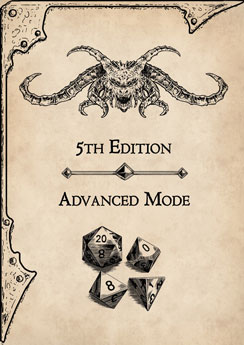Medium beast (animal), unaligned
Armor Class 12
Hit Points 13 (3d8)
Speed 50 ft., climb 40 ft.
Proficiency Bonus +2
Proficiency Bonus +2 (5th Edition Advanced Mode)
| STR | DEX | CON | INT | WIS | CHA |
|---|---|---|---|---|---|
| 14 (+2) | 15 (+2) | 10 (+0) | 3 (-4) | 14 (+2) | 7 (-2) |
Skills Perception +4, Stealth +6
Senses passive Perception 14
Challenge 1/4 (50 XP)
Keen Smell. The panther has advantage on Wisdom (Perception) checks that rely on smell.
Night Hunter (suggested). The panther has advantage on stealth check during nighttime.
Pounce. If the panther moves at least 20 ft. straight toward a creature and then hits it with a claw attack on the same turn, that target must succeed on a DC 12 Strength saving throw or be knocked prone. If the target is prone, the panther can make one bite attack against it as a bonus action.
Rear Claws (suggested). If both claws hits, the may rake with both its rear claws dealing 4 (1d4+2) slashing damage each as a bonus action. No hit roll required.
ACTION
- Multiattack (suggested). The panther makes three attacks, one with its bite and two with its claws.
- Bite. Melee Weapon Attack: +4 to hit, reach 5 ft., one target. Hit: (1d6 + 2) piercing damage.
- Claw. Melee Weapon Attack: +4 to hit, reach 5 ft., one target. Hit: (1d4 + 2) slashing damage.
5th Edition Advanced Mode
Limiting the power of a character and making the overall difficulty of the game harder, does not reduce the creativity, indeed it does quite the opposite.
The Game Master has the option to use any and all of the instances proposed in this guide, or just some of them according to their preference.
It is the lack of something that move and motivate characters, not the abundance of it
DESCRIPTION
A panther is a large, feline beast that has a muscular body and a long tail. It has a tan or light brown coat, sometimes with black spots or rosettes. It has a small head with round ears and yellow or green eyes. It has powerful jaws and sharp teeth, as well as retractable claws on its paws. A panther can grow up to 9 feet long and weigh up to 200 pounds, but some rare individuals can be larger.
COMBAT
A panther is a stealthy and agile hunter that prefers to stalk its prey from a distance and then pounce on it with a burst of speed. It uses its keen sense of sight, smell, and hearing to locate and track its prey, and its natural camouflage to blend in with its surroundings. A panther’s preferred tactic is to bite the neck or throat of its target, causing massive blood loss and suffocation. A panther’s bite and claw attacks are both deadly, dealing piercing and slashing damage respectively. A panther can also use its tail to balance itself or to lash out at enemies.
A panther is not afraid to fight multiple enemies at once, using its speed and agility to dart in and out of combat. It can also climb trees and rocks with ease, giving it an advantage in vertical terrain. A panther is wary of larger or more powerful foes, and will avoid them unless cornered or hungry.
HABITAT / SOCIETY
A panther is a solitary creature that roams the forests, hills, mountains, and plains of the world. It avoids civilization and humanoids, unless they encroach on its territory or offer easy prey. A panther marks its hunting grounds with urine and scratches, and will defend them fiercely from intruders.
A panther only seeks out other panthers for mating purposes, usually during the winter or spring. A female panther gives birth to a litter of one to six cubs after a gestation period of about three months. The cubs are born blind and helpless, and depend on their mother for protection and nourishment. The mother teaches them how to hunt and survive until they are about two years old, when they leave to find their own territories.
Some panthers form loose associations of up to ten members, usually related by blood or mating bonds. These groups hunt together and share their kills, but otherwise have little social interaction. They communicate with each other through roars, growls, purrs, and body language.
